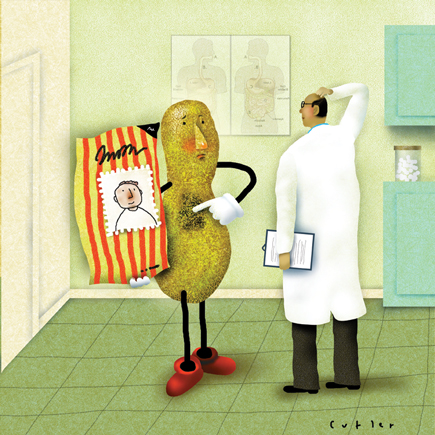Food allergies are a tough nut to crack
As public awareness of food allergies increases, identification and management into adulthood can be difficult to sort out, carrying the risk of misdiagnosis, according to specialists who are trying to improve physician education.
As public awareness of food allergies increases, identification and management into adulthood can be difficult to sort out, carrying the risk of misdiagnosis, according to specialists who are trying to improve physician education.
For example, a new patient reporting a food allergy may be basing it on symptoms dating back years. And even if the patient was correctly diagnosed at one point, the course of food allergy beyond childhood is variable. Some food allergies that are thought to resolve by early childhood, such as cow's milk and eggs, may actually persist far into the teenage and adult years.

There's also some indication based on research and anecdotal reports that people are less likely to rigorously protect themselves by avoiding foods and carrying epinephrine once they reach college age and beyond.
“I think adults have a more laid-back attitude about food allergy than the parents of children,” said Amal Assa’ad, MD, a professor of pediatrics at The University of Cincinnati and the Cincinnati Children's Hospital Medical Center in Ohio.
Challenging diagnoses
To provide some guidance for primary care doctors and specialists, an expert panel sponsored by the National Institute of Allergy and Infectious Diseases (NIAID) issued food allergy guidelines in a supplement to The Journal of Allergy and Clinical Immunology last December. The overview consolidates the latest research insights, including what's understood about the frequency of food allergy, related risk factors such as asthma, and optimal management. In particular, the expert panel emphasized that diagnosis can sometimes be complex and shouldn't solely rely on a positive blood or skin test result.
The uncertainties involved with food allergy aren't just limited to diagnostic challenges, said Marshall Plaut, MD, one of the guidelines' primary authors and chief of the allergic mechanisms section at NIAID.
“There are two other major problems in managing the disease,” he said. “One is that we do not have any treatment for food allergy other than avoiding the allergen and treating the emergence of an acute episode. And we do not have at the moment any diagnostic test to determine who is at risk of a severe allergic reaction versus who is not.”
But first it's important to nail down the diagnosis, a process that typically requires a detailed food history and related testing, said Matt Greenhawt, MD, MBA, director of food allergy research for the University of Michigan Food Allergy Center and assistant professor in the Division of Allergy and Clinical Immunology at the University of Michigan Medical School in Ann Arbor.
Otherwise, the patient may needlessly suffer the frustrations and social awkwardness of a restricted diet, he said. “That avoidance might be quite unnecessary and you might be contributing to a lower quality of life for that person.”
Beyond childhood
Given the varying approaches to diagnosis, it's been difficult for researchers to get a handle on the extent of food allergies, regardless of the age group involved. But the gap between patient belief and confirmed diagnoses is substantial, according to a 2007 meta-analysis cited in the expert guidelines.
Overall, children and adults report a similar percentage of food allergies—12% and 13% respectively, according to the meta-analysis. In comparison, the percentages confirmed through a food challenge were far lower, 3% for all age groups combined.
Nor is there a consensus on whether food allergies are increasing. The guidelines point to a 2009 analysis, published in the journal Pediatrics, which found an increase in the incidence of food allergies in children, as well as hospitalizations. But those results, from several national surveys, may have been influenced by heightened public awareness of food allergies, as well as more rigorous medical coding of food-related hospitalizations, the authors wrote.
Meanwhile, a review of available food allergy research conducted for the expert panel found that there are insufficient rigorous studies to reach a conclusion.
“It's unclear one way or the other,” said Jennifer Schneider Chafen, MD, MS, an internist and lead author of the literature review, published in May 2010 in the Journal of the American Medical Association. Dr. Chafen also is a health services researcher with the VA Palo Alto Health Care System and Stanford University in California.
Some allergies do appear more likely to resolve before adulthood, including reactions to milk, egg, wheat and soy, according to the expert panel's guidelines. Peanut and tree nut allergies are among those more likely to persist. Other allergies, most notably shellfish, might emerge for the first time in adults.
Above all, internists should keep in mind that the isolation of food-related complaints—intolerance versus food allergy—must not be based on skin or blood test results alone, Dr. Chafen said. A food intolerance may result in some type of adverse reaction, but lacks an immunologic basis, according to the guidelines. Lactose intolerance is considered a food intolerance as it's based on the inability to digest milk rather than an allergic reaction.
A patient with a less severe food reaction, such as a rash or stomach complaints, has less than a 50% chance of having a food allergy even if she tests positive, according to a key finding of the JAMA literature review that Dr. Chafen authored. It's not like a thyroid test, where the laboratory results typically point to a diagnosis, Dr. Chafen said: “There is a lot more grey area.”
Isolating symptoms
Dr. Assa’ad, who also is a primary author on the recent guidelines, said that it's not uncommon for her to see children who have never eaten peanuts, but were labeled as allergic at some point because of a positive allergy test.
In later years, she said, “These patients might show up at an internist's door and say, ‘I've been diagnosed with a peanut allergy.’ The next question should be: ‘How were you diagnosed?’”
Along with asking about the timing and the type of allergy tests, an internist should find out if an allergist interpreted the results, she said. It's also important to ask whether the food in question had actually been eaten, when the last reaction was, and what type of symptoms developed.
Headaches, fatigue and muscle aches usually aren't food allergy symptoms, said Marc Riedl, MD, MS, section head of clinical immunology and allergy for the David Geffen School of Medicine at the University of California, Los Angeles. Severe food reactions are more acute, such as breathing problems, and flare quickly, he said. “The vast majority of true allergic reactions will happen within 60 minutes of the ingestion,” he said. “Often it's much faster than that.”
When taking a food history, pay close attention to signs of inconsistency, according to specialists interviewed. A patient may say that she can eat yogurt, but can't drink milk. Or she might specify that shrimp is not a problem when it's fried, but causes a reaction when it's steamed or grilled. Such inconsistency, albeit only a portion of the diagnostic picture, could indicate that the patient doesn't have a food allergy, Dr. Greenhawt said.
Depending upon how rigorous their vigilance is, patients also may be periodically consuming the food in question, Dr. Assa’ad said. Ask whether they read labels and what steps they take at a restaurant. She pointed to a 2009 study by Dr. Greenhawt of 287 college students published in The Journal of Allergy and Clinical Immunology. The study showed that only four in 10 students always avoided the food to which they reported an allergy, and that intentional risk taking was rampant in this population, in particular among the students who reported they had never experienced a severe reaction previously.
An allergy specialist also should be involved with confirming a diagnosis, particularly if there is any uncertainty, Dr. Greenhawt said. The stakes are potentially high, he said. Just because a past reaction has been relatively mild does not guarantee that the next one will be.
The gold standard diagnostic test, a food challenge, requires an allergist's supervision and close monitoring for signs and symptoms, with epinephrine handy, while the patient consumes incremental quantities of the food, Dr. Greenhawt said. According to research cited by the guidelines, two-thirds of suspected food allergy cases will be ruled out by a food challenge.
For the patient, a food challenge can be “very, very liberating,” Dr. Greenhawt said. “If there is uncertainty over the diagnosis, you will learn through that experience what happens when you eat the food. The way I look at it, either way you are learning something very important.”
Proactive intervention
Once a food allergy is diagnosed, internists can play an influential role in educating patients about how to practice food avoidance and what steps to take if symptoms flare, experts said.
Although antihistamines may be helpful to ease minor reactions, such as mild skin rashes or itching, the patient must be told that those medications don't prevent a full-blown reaction, Dr. Riedl said. Epinephrine is the first-line treatment for severe reactions, and it should be administered into a muscle. Training is crucial, so patients feel prepared to self-administer a pre-filled syringe of epinephrine into their thigh, along with calling 911. Loved ones also should be trained in case the individual becomes incapacitated, he said.
“The epinephrine should certainly be given if they are starting to have significant difficulty breathing. Or if they have cardiovascular symptoms, [such as] they are beginning to get dizzy,” Dr. Riedl said.
But the recent study of college students indicates that epinephrine adherence is not ingrained. The findings, based on those who reported a food allergy or prior food allergy symptoms, found that just 6.6% of the 287 students reported always carrying epinephrine. The percentage was higher, 40.4%, among a smaller group who reported prior symptoms of anaphylaxis.
Although the data are still limited, there also are some worrisome signs that adolescents and young adults are more likely to die from anaphylaxis, Dr. Plaut said. He pointed to a 2001 study involving 32 anaphylactic fatalities reported to a national registry. Nearly all occurred in adolescents and young adults—four were younger than age 13—and only four of the 32 had epinephrine readily available. A follow-up analysis, based on 31 fatalities from 2001 through 2006, identified a similar pattern.
Shifting knowledge
The two analyses involving fatalities also noted a link to asthma, which nearly all of the individuals had. This association is similarly highlighted in the expert guidelines. Another example of evolving knowledge involves the administration of the influenza vaccine in adults with known egg allergy. The expert panel cited several recent studies that indicate successful vaccination, sometimes with a modified dosing regimen.
In October 2010, the American Academy of Allergy Asthma & Immunology issued a guidance paper saying that recent studies have found that most people with a confirmed egg allergy can be safely vaccinated if precautions are taken, such as a split dose. The major aspects of the paper are incorporated in an official practice parameter from the Joint Taskforce on Practice Parameters, published in January in Annals of Allergy, Asthma, and Immunology.
Regardless of the dosing strategy, close monitoring is crucial for at least 30 minutes following vaccination, said Dr. Greenhawt. In some circumstances, vaccination of such patients may represent too high a level of risk for some clinicians to assume, he said. “This is certainly a case where a referral to an allergist is recommended.”
As research accumulates, more components of the food allergy puzzle will be unlocked, Dr. Riedl said. One example he cited is an ongoing effort to follow groups of children to determine how frequently food allergies persist into adulthood.
At this point, he acknowledged, “There is whole lot of stuff that we honestly don't understand very well. ... Food allergy, in my specialty of allergy, has been a little bit neglected. But that's changing. That's the good news, that there are more research resources being put into this.”





